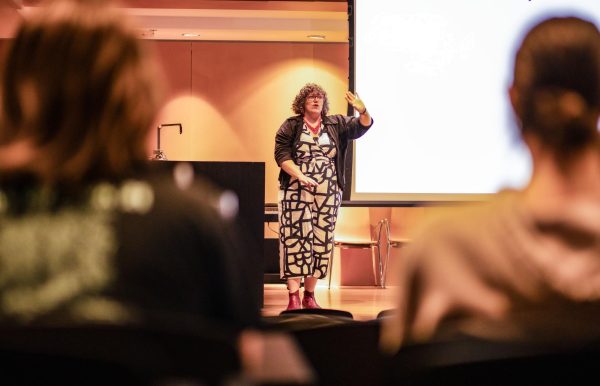NASA ambassador visits campus
February 17, 2019
James Knapper, a NASA solar system ambassador, gave a presentation on current and planned expeditions to Mars and the impacts of extended space travel on astronauts manning such missions.
The event, titled “Biological Effects on the Human Body During Spaceflight,” was part of the Department of Biological Sciences’ annual FebFest Biology Open House and was open to university and high school students alike.
The audience of the event was comprised of several groups of high school students and their teachers who had come to Eastern to tour the campus, meet with professors and current students and explore the programs offered by the Biology Department.
Knapper prefaced the presentation by expressing his gratitude for the opportunity to speak as part of the Open House, and asked students a series of general-knowledge questions about the state of space exploration and current reports of NASA’s activities in the news.
He began the presentation with a brief history of the probes and manned missions launched into space and the possibilities of sending missions to Mars, which he said NASA aims to do by the early 2030s.
In explaining the biological effects such a voyage would have on the human body, Knapper presented the findings of NASA’s Human Research Program, which was established to study human ability to survive long-term spaceflight.
The study, he detailed, outlined the five most dangerous hazards that astronauts could expect to face over the course of a six-month mission to Mars: increased exposure to space radiation, the weakening of the body in zero gravity, the impossibility of aid from Earth, the behavioral effects of social isolation and the psychological stress of working in a dangerous closed environment.
Knapper was quick to follow these dangers with the methods NASA employs to combat them, including extensive training for astronauts on Earth, various technological solutions to problems that could arise during the mission and specialized rehabilitation programs for returning astronauts.
In an interview after the conclusion of the presentation, Knapper discussed the financial and political hurdles of sending a manned mission to Mars, including the necessity of funding and international cooperation between states with active space programs.
On the subject of his role as a Solar System Ambassador, Knapper explained that his job is to keep the public up to date on NASA’s programs and said he was surprised at the outpouring of public sentiment for the Mars rover Opportunity, whose 15-year mission came to an end this week.
Opportunity, Knapper said, is survived Curiosity, who will be joined on Mars by a similar rover in 2020; their mission together is to provide researchers with the data needed to assess the possibility of converting subterranean ice into oxygen, a crucial first step in the far-off dream of establishing a research base on the surface of the planet.
Knapper said the potential is there, and ongoing international cooperation on such projects has nurtured a sincere faith in the continued progression of humanity’s exploration further into the solar system.
Maya Hunter can be reached at 581-2812 or at [email protected].













































